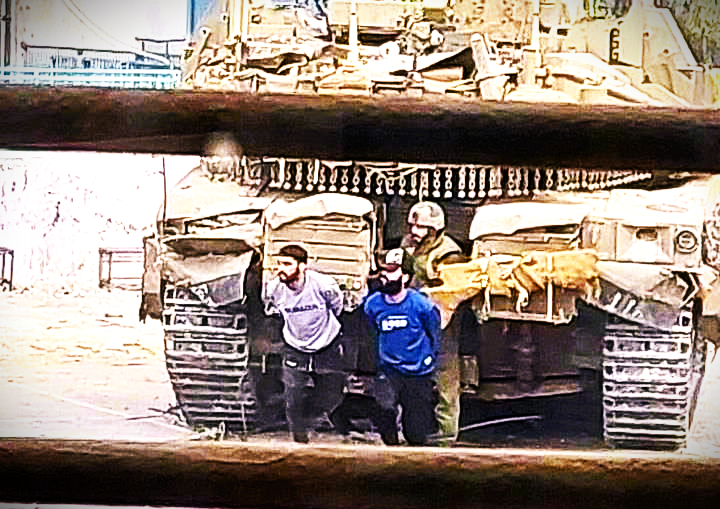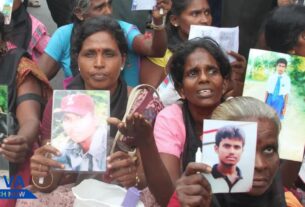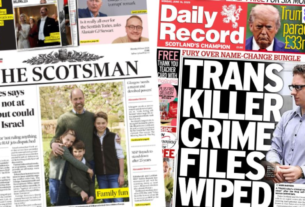TEL AVIV – In the grim theater of war in Gaza, a disturbing tactic has emerged from the shadows: the use of Palestinian civilians as human shields by Israeli forces. Testimonies from former detainees and Israeli soldiers, gathered by the Associated Press, suggest this practice was not only present, it was systematic.
One of the most harrowing accounts comes from Ayman Abu Hamadan, a 36-year-old Palestinian man who says he was taken by Israeli troops and thrust into a role no civilian should endure. Stripped of his autonomy and dignity, Abu Hamadan was dressed in military fatigues, a camera affixed to his helmet, and sent ahead of soldiers into potentially booby-trapped buildings and tunnels across northern Gaza.
“The only time I wasn’t blindfolded,” he told AP, “was when they made me their shield.”
For over two weeks, he claims, he was shuffled from one unit to another, each time forced to lead operations unarmed, untrained, and under threat of death if he refused. His account is not isolated. Interviews with other Palestinian detainees and Israeli military personnel suggest a deliberate, repeated pattern of abuse that may represent a flagrant breach of international law.
Inside a Forbidden Tactic
The practice of using civilians to shield combatants is explicitly prohibited under the Geneva Conventions and condemned by international courts as a war crime. In 2005, Israel’s own Supreme Court outlawed the use of human shields following a wave of public and legal outcry.
Yet current and former members of the Israel Defense Forces (IDF), speaking on condition of anonymity, told AP that the prohibition is widely ignored in the field especially during high-risk operations in dense urban areas of Gaza.
“Nearly every unit had a guy,” said one Israeli officer, who detailed how soldiers would use detained Palestinians to clear rooms, scout tunnels, or trigger potential ambushes. “It was an unofficial policy, something that happened so often, it became routine.”
Orders, he claimed, were often issued by commanders at the platoon or company level, with tacit approval from higher up the chain of command.
A War of Narratives
Israel has long accused Hamas of using civilians as human shields, hiding weapons in schools, operating from hospitals, and embedding fighters within residential neighborhoods. That allegation has served as a central pillar in justifying the scale of Israel’s military response in Gaza, where tens of thousands of Palestinians have been killed since the war began.
But these new allegations flip the narrative, implicating Israeli forces in the very tactic they condemn.
In a statement responding to the report, the IDF reiterated that its operational code “strictly prohibits the use of civilians in combat roles” and stated that it investigates all credible accusations of misconduct. However, rights groups argue that such internal probes rarely lead to meaningful accountability.
The United Nations and international human rights organizations have condemned the reported use of civilians as shields, calling for independent investigations and warning that such practices could constitute war crimes.
“You Have No Choice”
The language used by detainees like Abu Hamadan paints a picture not just of coercion, but of terror. “They told me, you have no choice. Do this or we’ll kill you,’” he said. “When one unit was done with me, they handed me off to another like I was equipment, not a person.”
He described being beaten, denied food, and used in at least a dozen high-risk missions all while being filmed, seemingly for tactical or intelligence purposes. At no point, he says, was he told how long he would be detained, or when he would be released.
Other Palestinians shared similar stories of being blindfolded, detained without charge, and then used to “test” unsafe environments while under direct military supervision.
Global Implications
The broader implications of these allegations are profound. If the use of human shields by Israeli forces is shown to be systemic, it could drastically shift international perceptions of the conflict and intensify legal scrutiny from bodies such as the International Criminal Court (ICC).
Thus far, the diplomatic response has been a reflection, perhaps, of the geopolitical sensitivities surrounding the Israeli-Palestinian conflict. But pressure is growing. Calls for independent investigations are mounting, and the credibility of institutions charged with upholding international law is on the line.
For those on the ground in Gaza, though, the impact is immediate and visceral.
“There was no protection, no law, no mercy,” said one former detainee. “Only fear.”
A Moral Reckoning
This war, like so many before it, is being fought as much in the court of public opinion as it is in the streets of Gaza. Both Israel and Hamas have long accused one another of exploiting civilians, and both deny wrongdoing. But when civilian lives are weaponized, regardless of who pulls the trigger, the result is the same: the erosion of basic human dignity and the laws that are meant to protect it.
As more testimonies emerge and scrutiny intensifies, the question remains: Will this lead to justice, or simply become another atrocity lost to the archives of an unending war?




